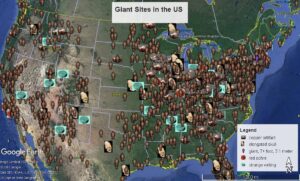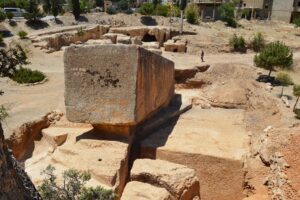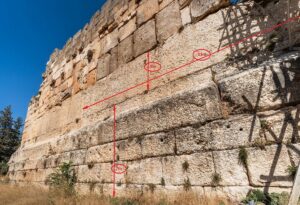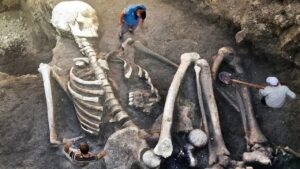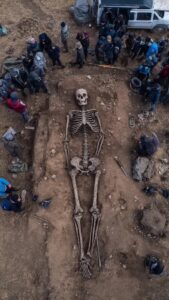Ek hoop om die eerste week in Desember 2024 ‘n nuwe opname te doen en by te voeg, en dit handel oor die verskillende ooreenkomste wat ons met die HERE kan aangaan.
Ek het onlangs die volgende videos opgelaai:
Die eindtyd soos uitgelig deur Jesus in Matteus 24 en 25.
Apartheid in die nuwe Suid Afrika
Die volgende videos is ook beskikbaaar op YouTube:
The Covenant of Righteousness: 8 videos Time for all videos Between 5 and 6 hours
Die Verbond van Geregtigheid: 10 videos Tydsduur 6 ure
A Wakeup Call Time 6+ hours, 12 videos
My Begrafnis
Hier sal u die skakel vind na my begrafnis video
grote = 108 MB goed genoeg vir selfoon
Giants
What happened to the giants described in Genesis 6 in the Bible?
Gen 6:4 The Nephilim were on the earth in those days, and also afterward, when the sons of God came in to the daughters of men, and they bore children to them. Those were the mighty men who were of old, men of renown.
Origins
Ancient records worldwide describe giants born from unions between powerful sky beings (the Anunnaki) and human women. These hybrids—known as Nephilim, Rephaim, Anakim, and others—were not mythical spirits but flesh-and-blood beings with superior strength and knowledge. The Anunnaki, advanced beings from the heavens, were revered as gods by early humans, and their offspring became rulers and builders of early civilizations.
Evidence
-
Archaeological Finds: Skeletons up to 12 feet tall have been unearthed across North America (Michigan, Iowa, California), often with features like double rows of teeth and elongated skulls.
-
Native American Legends: Tribes such as the Paiute, Choctaw, and Cherokee tell of giant races—some red-haired, some pale-skinned—who built cities and fought wars with humans.
-
Suppressed Reports: Alleged removal of giant skeletons by institutions and modern encounters, such as a 13-foot giant reportedly killed in Kandahar (2002).
-
Oversized Tools and Megaliths: Weapons, armor, and structures like Gilgal Rephaim (Israel) and Baalbek (Lebanon) suggest builders of massive stature and strength.
Historical and Biblical Connections
-
Gilgamesh: A Nephilim king, 2/3 Anunnaki and 1/3 human, depicted as a giant in Mesopotamian texts.
-
Bible References: Numerous passages mention giants—Goliath (9’9”), Og of Bashan (13.5-foot bed), and entire tribes of giants (Anakim, Rephaim, Emim).
-
Post-Flood Lineage: Giants persisted through Ham’s descendants after the Flood, linking the bloodline to Canaanite and Mesopotamian civilisations.
Theories and Implications
-
Giants were products of genetic engineering by the Anunnaki.
-
The Flood acted as a genetic reset but preserved hybrid DNA through Noah’s family.
-
These hybrids ruled as kings and builders, leaving behind megalithic monuments, myths, and scriptures that shaped human history.
Conclusion
The giants of old were not mere legends but influential beings—hybrids of divine lineage and human blood—who established early empires and were remembered as gods due to their power, size, and knowledge.
To start the explanation here is an example: The Five Greatest Giants Ever Mentioned in the Bible
-
Giants of Old: Origins and History
Genesis 6 verse 4 : “The Nephilim were on the earth in those days, and also afterward, when the sons of God came in to the daughters of men, and they bore children to them. Those were the mighty men who were of old, men of renown.”
Origins
Ancient records worldwide describe giants born from unions between powerful sky beings (the Anunnaki) and human women. These hybrids—known as Nephilim, Rephaim, Anakim, and others—were not mythical spirits but flesh-and-blood beings with superior strength and knowledge. The Anunnaki, advanced beings from the heavens, were revered as gods by early humans, and their offspring became rulers and builders of early civilizations.
Evidence
-
Archaeological Finds: Skeletons up to 12 feet tall have been unearthed across North America (Michigan, Iowa, California), often with features like double rows of teeth and elongated skulls.
-
Native American Legends: Tribes such as the Paiute, Choctaw, and Cherokee tell of giant races—some red-haired, some pale-skinned—who built cities and fought wars with humans.
-
Suppressed Reports: Alleged removal of giant skeletons by institutions and modern encounters, such as a 13-foot giant reportedly killed in Kandahar (2002).
-
Oversized Tools and Megaliths: Weapons, armor, and structures like Gilgal Rephaim (Israel) and Baalbek (Lebanon) suggest builders of massive stature and strength.
Historical and Biblical Connections
-
Gilgamesh: A Nephilim king, 2/3 Anunnaki and 1/3 human, depicted as a giant in Mesopotamian texts.
-
Bible References: Numerous passages mention giants—Goliath (9’9”), Og of Bashan (13.5-foot bed), and entire tribes of giants (Anakim, Rephaim, Emim).
-
Post-Flood Lineage: Giants persisted through Ham’s descendants after the Flood, linking the bloodline to Canaanite and Mesopotamian civilisations.
Theories and Implications
-
Giants were products of genetic engineering by the Anunnaki.
-
The Flood acted as a genetic reset but preserved hybrid DNA through Noah’s family.
These hybrids ruled as kings and builders, leaving behind megalithic monuments, myths, and scriptures that shaped human history.
Conclusion
The giants of old were not mere legends but influential beings—hybrids of divine lineage and human blood—who established early empires and were remembered as gods due to their power, size, and knowledge.
- Who Were the Giants in Genesis 6?
- In Genesis 6:4, the term used is Nephilim (נְפִלִים).
- They are described as “the mighty men of old, men of renown.”
- The passage suggests they appeared when “the sons of God” (בְּנֵי־הָאֱלֹהִים) had relations with “the daughters of men.”
- Interpretations differ:
- Angelic view: The “sons of God” were fallen angels who produced hybrid offspring with humans.
- Human view: The “sons of God” were descendants of Seth (godly line) intermarrying with daughters of Cain (ungodly line), and the Nephilim were simply mighty warriors, not literal giants.
- Ancient kings view: Some Jewish and Mesopotamian traditions suggest they were tyrant rulers.
- What Happened to Them?
- Before the Flood: Genesis 6 says they existed before the Flood and “also afterward” (v. 4).
- During the Flood: Most interpreters believe the original Nephilim were wiped out in the Flood of Noah (Genesis 7), which destroyed all flesh except those on the Ark.
- After the Flood: The Bible mentions giants again later:
- Numbers 13:33 – The Israelite spies say: “We saw the Nephilim there… we seemed like grasshoppers in our own eyes.”
- Deuteronomy 2–3 – Mentions Rephaim, Anakim, and Og king of Bashan, described as very large.
- This raises questions: Did some survive? Or were these later giants different groups, not the original Nephilim but similar in stature?
- Theories on Their Fate
- Complete Destruction View: All original Nephilim perished in the Flood; later references are metaphorical or about other large people.
- Second Incursion View: Some fallen angels may have repeated this sin after the Flood, creating another line of giants.
- Survivors Theory: A few Nephilim or their genes may have survived through the wives of Noah’s sons (though this is speculative).
- Spiritual Angle
The main point of Genesis 6 is human corruption and divine judgment, leading to the Flood. The Nephilim are a symbol of rebellion against God’s created order.
-
-
1. Biblical Timeline of Giants
-
Here are the main references in order:
Genesis 6:4 – Before the Flood
- “The Nephilim were on the earth in those days—and also afterward—when the sons of God went to the daughters of humans and had children by them.”
- This is the first and only place the word Nephilim appears in the Torah.
After the Flood (giants appear again):
- Numbers 13:33 – Israelite spies in Canaan: “We saw the Nephilim there (the descendants of Anak come from the Nephilim). We seemed like grasshoppers…”
- Deuteronomy 2:10-11 – Mentions the Emim, great and tall people, considered like the Anakim, counted among the Rephaim.
- Deuteronomy 3:11 – “Og king of Bashan remained of the remnant of the Rephaim; his bed was 9 cubits long” (about 13 feet!).
- Joshua 11:21-22 – Joshua destroys the Anakim except in Gaza, Gath, and Ashdod (Philistine areas).
- 1 Samuel 17 – Goliath of Gath (about 9 feet tall) fights David.
- 2 Samuel 21 – Mentions other Philistine giants, “descendants of the Rapha in Gath.”
📌 Summary: Before the Flood = Nephilim. After the Flood = Rephaim, Anakim, and Philistine giants (possibly related, or just large humans).
-
-
2. Jewish & Christian Traditions on Their Fate
-
- Jewish view (Talmud & Midrash):
- Most rabbis say all Nephilim died in the Flood.
- Later giants (Anakim, Rephaim) are unrelated—just large humans.
- Christian view (Church Fathers):
- Early Fathers like Augustine taught Nephilim were destroyed in the Flood and saw later giants as normal men of unusual size.
- Others (influenced by Enoch) suggested fallen angels repeated the sin after the Flood.
- Survivor theory (minor tradition):
- Some suggest Noah’s daughters-in-law carried Nephilim blood, allowing giant genes to survive.
-
-
3. Dead Sea Scrolls & Book of Enoch
-
- 1 Enoch 6–16 (part of the Dead Sea Scrolls) expands Genesis 6:
- The “sons of God” are called Watchers (angels).
- They marry women, produce giant offspring (up to 450 feet in some exaggerated texts).
- Giants became violent and cannibalistic, bringing corruption.
- God sends the Flood to destroy them.
- Their spirits become evil spirits/demons after death (Enoch 15:8–12).
- Jubilees (another Jewish text):
- Repeats this story, adds that God commanded angels to bind the Watchers in the abyss.
- These writings strongly influenced early Christian thought and later demonology.
✅ Summary of their fate according to all views:
- Original Nephilim: Destroyed in the Flood.
- Their spirits: Became demons (per Enoch, not canonical Bible).
- Later giants: Separate races (Anakim, Rephaim, Philistine giants) fought by Israel.
-
Are giants described in other books of that time?
What about the Book of Jasher? Does that change anything?
The Book of Jasher (Sefer haYashar) is mentioned in Joshua 10:13 and 2 Samuel 1:18, but the text we have today is later and not part of the biblical canon. Still, it does expand on some Genesis narratives, including the Nephilim.
Here’s how Jasher relates to the giants and whether it changes interpretations:
✅ 1. What Jasher Says About Giants
- In Jasher 4:18, it says:
“And their judges and rulers went to the daughters of men and took their wives by force… and the sons of men taught the mixture of animals of one species with another.” - It links the violence and corruption of Genesis 6 to unnatural unions and corruption of creation.
- It also mentions that the generation of the Flood grew very tall and strong, hinting at giants without explicitly calling them Nephilim.
- Jasher 5:2 describes the wickedness leading to the Flood, again emphasizing genetic corruption and immorality.
✅ 2. Does It Change the Interpretation?
- Not really, because:
- It still confirms the Flood destroyed them.
- It agrees that the “sons of God” took women, though Jasher frames it as rulers and judges, not necessarily angels.
- So Jasher seems closer to the human (Sethite or ruler) interpretation, rather than the angelic one.
- No mention of spirits becoming demons (that idea comes from Enoch, not Jasher).
✅ 3. Key Difference From Enoch
- Enoch = clearly says fallen angels fathered giants → their spirits became demons.
- Jasher = focuses on corrupt human rulers and genetic tampering (like hybrid animals).
- So if you take Jasher seriously, it leans away from the “fallen angel” theory and more toward human corruption plus advanced wickedness.
📌 Bottom line: Jasher does not overturn the Genesis interpretation but adds details that shift emphasis toward human rulers, not supernatural beings. This makes it closer to the Sethite view than the angelic view.
Here’s a comparison table showing what Genesis, Book of Enoch, and Book of Jasher say about the giants and their fate:
Comparison of Giants in Genesis, Enoch, and Jasher
| Aspect | Genesis (Canon) | Book of Enoch | Book of Jasher |
| Who are the “sons of God”? | Ambiguous – could be angels or humans | Fallen angels (“Watchers”) | Human rulers/judges |
| How did giants appear? | Sons of God + daughters of men | Angels marry human women → Nephilim born | Powerful rulers took women; also hints of genetic corruption |
| Description of giants | “Nephilim… mighty men of old” | Giants up to 300–450 ft (symbolic exaggeration) | Very tall, strong men; no extreme sizes given |
| Reason for Flood | Wickedness and corruption of mankind | Violence from giants and angelic sin | Violence, immorality, and genetic mixing (including animals) |
| Fate of giants | Destroyed in the Flood | Destroyed in Flood; spirits become demons | Destroyed in Flood |
| Post-Flood giants? | Yes (Anakim, Rephaim) | No explicit mention | No clear mention |
| Spiritual aftermath | Not stated | Spirits = demons on earth | Not stated |

